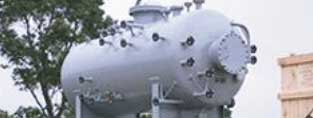
- (03) 5909 8218
- enquiry@fusionweld.com.au
External Floating Roof Storage Tanks: Uses and Applications
November 14, 2017

What exactly are external floating roof storage tanks? To a novice, the term conjures up an image of a lightweight tank, one that floats like a ship's metal hull. In point of fact, these tanks don't float. Rather, it's the floating roof above and inside the tank that's buoyed by a stored fluid. Typically speaking, an EFRST will contain a petroleum product.
What Kind of Petroleum Product?
That's a good question. Furthermore, that question will direct us towards the reason for installing a floating roof. Picture a drum-shaped tank. Inside that metal-panelled container, there's crude oil, a processed condensate, or a petroleum product of some kind. The roof seems to exist solely to stop the elements from diluting or contaminating the fossil fuel derivatives, right? Well, couldn't a regular tank do the same thing? Couldn't a fixed roof safely protect the oily medium from rain or blown debris? A simple covering obviously isn't the answer. There's a more elaborate purpose in mind here, one that's designed to stop a void forming above the fluid line.
Vapour Space Management
The open cylinder contains a fluid that creates a vapour component. If the tank had a fixed ceiling, then the vapour space would generate VOCs (Volatile Organic Compounds), and those compounds would enter the atmosphere in this gaseous state. External floating roof storage tanks manage the vapour space. Actually, they entirely eliminate that void by floating right on top of the fluid surface. However, as with any truly advanced engineering asset, there's more to this containment equipment than an open-topped cylinder and a circular sheet of floating metal. For starters, a dedicated rim seal is required. Otherwise, the vapours can still seep past the roof panel.
Constructing the Supplementary Components
They're installed in biofuel facilities and petroleum storage sites, places that store stabilized liquids. Waxy crude oil reservoirs are commonly stockpiled inside these tanks, so how does this vapour space feature operate? Well, pontoons and pans keep the roof buoyant. Curved and sloped variants remove accumulated water, so expect a series of drains installed somewhere in the vicinity of the floating roof. Other than these essential features, a reliable rim seal must be installed between the roof and the storage unit.
Fuel gauges and drains, guide poles and access ports, the design of an external floating storage tank (EFST) is relatively uncomplicated, although the existing design features must be reliable. That design concludes with the geometry of the roof, including the flotation pontoons, the curving ribs, and the rim seal type.
Contact Details
Fusion - Weld Engineering Pty Ltd
ABN 98 068 987619
1865 Frankston Flinders Road,
Hastings, VIC 3915
Ph: (03) 5909 8218
Optimized by NetwizardSEO.com.au
Recent Posts
- Heat Exchanger Maintenance in Melbourne: Minimising Risk in Power Generation Facilities
- Compressed Hydrogen Storage Vessels: Material Selection, Design & Australian Standards
- Welding QA/QC in Oil & Gas Pressure Vessel Fabrication – Ensuring Code Compliance
- AS1210 vs ASME VIII Pressure Vessel Code: Key Differences for Australian Projects
- Mitigating Hydrogen-Induced Cracking in Pressure Vessels: Engineering and Material Strategies
- Storage Tank Solutions Australia: Field-Erected, Prefabricated & Self-Bunded Explained
- Reducing Environmental Risks: Self-Bunded Tanks in Australian Oil & Gas Operations
- Precision in Production: How Pressure Vessels Are Manufactured for Industrial Safety
- Shell & Tube Heat Exchangers: Improve Thermal Control & Energy Recovery in Petrochemical & Pharmaceutical Plants
- In-Service Inspection for Compressed Air Receivers for Power Plant Shutdown Prevention
- Power Plant Pipe Spooling Fabrication – Get Rapid, Code-Compliant Spools Ready for Installation
- Field Erected Tanks: Safe, Reliable On-Site Fuel Storage Solutions in Australia
Posts 2026
- Heat Exchanger Maintenance in Melbourne: Minimising Risk in Power Generation Facilities
- View all articles…
Posts 2025
- Compressed Hydrogen Storage Vessels: Material Selection, Design & Australian Standards
- Welding QA/QC in Oil & Gas Pressure Vessel Fabrication – Ensuring Code Compliance
- View all articles…
Posts 2024
- Large Process Vessels: Optimising the Design for Maximum Efficiency [2025]
- Pressure Equipment Management System Installation: Detect Equipment Faults Early
- View all articles…
Posts 2023
- Pressure Piping System Inspection: A Gift of Safety for the Holidays
- Deaerator Inspections by Fusion-Weld Engineering and How They Reduce System Downtime
- View all articles…
Posts 2022
- How Fusion Weld Keeps Up With AS-NZS ISO 9001:2008 Standard
- Boiler Equipment Safety Inspection During the Summer Season
- View all articles…
Posts 2021
- Avoid These Factors and Practices that Contribute to Sealing Damage in Pressure Vessels
- Do's And Don'ts Of Industrial Boiler Inspection And Maintenance From Fusion-Weld
- View all articles…
Posts 2020
- What are the Risks and Hazards Involved in Pressure Vessel Equipment?
- How to Know if Your Pressure Equipment Needs Repair or Replacement?
- View all articles…
Posts 2019
- Factors that Contribute to Pressure Vessel Failure
- Pressure Vessel Regulations in Australia: What are the Mandatory Requirements?
- View all articles…
Posts 2018
- Pros and Cons of Spherical vs. Cylindrical Pressure Vessels
- What are the Different Hazard Levels in Pressure Vessels?
- View all articles…
Posts 2017
- Transportable Pressure Vessels: The Importance of Inspection and Safety Checks
- Fracture Mechanics and Stress Analysis of Cracks in Pressure Vessels
- View all articles…
Posts 2016
Posts 2015
- What Are Deaerators & Feedwater Vessels?
- Precautions and Safety for Compressed Air Receiver Vessels
- View all articles…
Posts 2014
- Demonstrating In-process Inspection Procedures
- Static Grounding Practices and Standards
- View all articles…